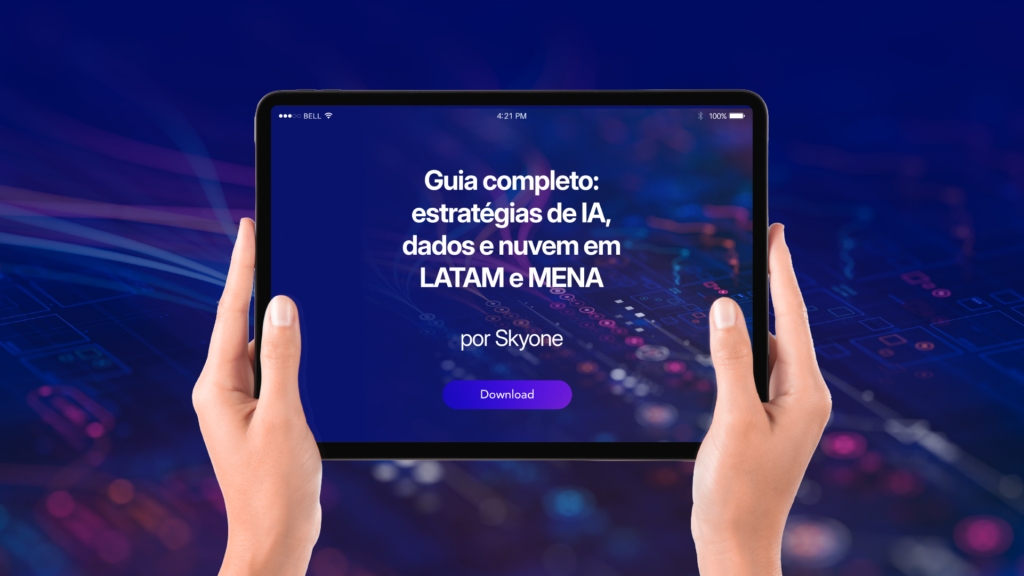Introduction: Why controlling invisible data has become a priority
There's something that goes unnoticed in many companies: the illusion that migrating data to the cloud is the same as controlling it.
In practice, what grows with the cloud is not only processing capacity, but also the complexity of understanding where data resides, who accesses it, and how much trust can be placed on it.
According to Dataversity 's Data Governance Trends 2024 study , 62% of organizations have had to reevaluate their governance programs due to a lack of clarity about their own data, and up to 40% of the IT budget is consumed solely by correcting flawed governance issues. In other words, it's not a lack of technology, but rather a lack of visibility and control.
This blind spot grows precisely in the most advanced environments, where automation, integrations, and multiple providers fragment the view of data. And it's in this invisible space , between flows, APIs, and system silos, that the greatest risks lurk .
Cloud data governance is the antidote to this disconnect, as it ensures traceability, trust, and context without sacrificing the agility the business demands.
But before fixing what's out of place, we need to understand what's slipping under the radar. Therefore, in the following topics, we explore the main enemies of modern governance and how to transform data control into a strategic asset.
Enjoy the read!
2. The 5 Great Enemies of Modern Governance
A lack of governance doesn't always stem from a lack of structure. More often than not, it stems from haste , an attempt to scale, integrate, and automate faster than can be controlled .
And it's in this disconnect that the greatest enemies of modern governance emerge: silent, difficult to perceive, but with a direct impact on data reliability. Check out what they are:
- Data without a defined owner : Without clear governance roles, such as data ownership and data stewardship , data becomes orphaned. This hinders accountability for incidents and the quality of decisions based on them;
- Superficial or outdated classification : When data isn't classified consistently, context regarding what's sensitive, strategic, or disposable is lost. This lack of visibility affects compliance , prioritization, and even the way data flows between systems.
- Static policies in dynamic environments : the cloud is alive. Multicloud and hybrid environments change constantly, and policies that don't keep pace end up ignored. Effective governance requires guidelines integrated into the operational flow, not manuals forgotten in the repository;
- Lack of traceability and reliable history : Without data lineage (tracking the entire data trajectory) and consistent audit trails, it's impossible to understand how data evolved until it reaches a report or dashboard . The consequence is simple: unreliable decisions;
- Data culture restricted to IT : governance isn't exclusive to the technical area. When business areas don't share responsibility for data, control loses strength, and governance ceases to be strategic and becomes bureaucratic.
These five factors explain why so many governance initiatives stagnate before delivering concrete results. The path to overcoming them begins with structure and the clarity that governing isn't just about control, but also about sustaining a foundation of trust that allows for secure .
This foundation is what we'll explore below, in the four pillars that support efficient, scalable governance adapted to the cloud.
3. The foundation of efficient governance: 4 pillars that work
Good governance begins with a clear map of what needs to be controlled . But in practice, what we see are companies trying to manage complex flows with structures designed for another time, when data still sat "still" inside a server.
In the cloud, everything changes: data is born distributed, constantly transforms, and travels between environments. Controlling this requires four pillars that support modern governance. Not as linear steps, but as gears that feed off each other . Check it out:
1. Discovery and classification: giving name and context to what exists
The first step isn't protecting, it's understanding. Mapping what exists, where it is, and its sensitivity level lays the foundation for any decision. Without this visibility, a company may spend more time protecting irrelevant data than caring for truly critical data.
In the cloud, this step needs to be continuous, with tools that automatically identify and reclassify data, without relying on manual inventories.
2. Policies and controls: rules that work beyond paper
Many companies have impeccable data policies… until they need to enforce them. The difference between bureaucracy and governance lies in execution.
Access, retention, and usage rules need to be automated and context-based: who accesses, when, and why. This is what separates control from rigidity.
3. Monitoring and auditing: knowing what happens, while it happens
Simply recording logs : you need a live view of the data. Data lineage offers this transparency. But the difference lies in using this visibility to act quickly: detect deviations, correct anomalies, and audit flows in near-real time.
4. Processes and people: governance cannot stand alone
Tools only work when there is a culture: each area that creates, transforms, or consumes data needs to understand its responsibility in the process.
True governance is achieved when IT, data, and business share the same goal: to trust the information they use.
These four pillars form the core of practical and scalable governance , where control and fluidity coexist.
And it is from them that best practices emerge that can transform guidelines into real results, the topic of our next section.
4. Best practices that avoid mistakes and accelerate results
Data governance ceases to be theoretical when it fits into the real-world flow of a company. But this is where many initiatives fail, trying to apply generic models to environments that change daily.
The key is to create practices that are consistent enough to ensure control, yet flexible enough to keep pace with the cloud, such as:
- Start small, but with purpose : Not all governance needs to be fully developed. Focusing on the most critical data domains (those that support strategic decisions or require compliance) helps generate rapid value and prove the model's effectiveness. When governance demonstrates results, it naturally expands;
- Treat your data inventory as a living organism : The data catalog is the heart of governance. It needs to be continually updated, reflecting new integrations, systems, and usage contexts. An outdated inventory is like an old map: it provides direction, but doesn't lead to the right destination.
- Apply context-aware control : Not all data requires the same level of restriction. Context-based controls, considering who accesses it, from where, and for what purpose, balance security and fluidity. This type of adaptive governance avoids both rigidity and unnecessary exposure.
- Automate where human error weighs most : Automation doesn't replace governance, it reinforces it. Using tools to validate policies, log access, and perform continuous audits reduces noise and frees up teams for higher-value tasks. But every automated process requires oversight; after all, human supervision is what ensures the system remains reliable.
- Treat data culture as a strategy, not a campaign : governance isn't imposed, it's built. When departments recognize the direct impact of data quality and traceability on their decisions, control ceases to be an obligation and becomes an operational standard.
These practices work because they strengthen governance's most valuable assets: predictability and trust .
When the process is consistent, data ceases to be an unstable variable and becomes a shared, accessible, auditable, and useful point of truth . This is where technology makes a difference. It doesn't replace the process, but rather expands the reach of governance, connecting flows, automating controls, and ensuring traceability at scale.
Therefore, in the next section, it's time to see how the right platforms transform this consistency into intelligence, and why this is the natural path for modern governance in the cloud. Stay tuned!
5. Technologies that unlock data governance
Data governance depends on a technology ecosystem capable of connecting, automating, and making sense of information in real time and across any cloud environment.
More than isolated tools, it's the right combination of technologies that ensures visibility, control, and trust. Among the most important, four layers form the foundation of modern governance:
- Data Integration Platforms (iPaaS) : These solutions connect applications, legacy systems, and distributed databases, ensuring the continuous and traceable flow of information. They are the foundation of interoperability and the first step toward eliminating silos and standardizing access and usage policies.
- Policy automation and process orchestration : Automation is the engine that makes governance work at the pace of the cloud. Workflow, RPA, and rule management tools help enforce policies consistently, reducing human error and compliance costs.
- data lineage platforms : Governing is seeing. Solutions that map the origin, transformation, and destination of data offer end-to-end traceability—essential for audits, quality, and reliable decision-making.
- Artificial intelligence (AI) and predictive analytics : AI brings predictability and scale to governance . Models trained to classify sensitive data, identify anomalies, and suggest corrections make control more intelligent and proactive, increasing operational maturity.
At Skyone , these layers are integrated into Skyone Studio , our platform that combines integration, automation, and intelligence to orchestrate the complete data cycle. With it, companies gain real-time traceability, automated policies, and a layer of continuous intelligence that supports decisions with security and context.
This technological synergy doesn't replace processes or people, but rather enhances them. It transforms governance into a predictable, scalable, and connected system.
If your company seeks this visibility and wants to understand how to strengthen governance in the cloud, talk to one of our experts! We're ready to help you transform scattered data into reliable competitive advantage .
6. Conclusion: Without governance, your data becomes noise
For a long time, we believed that having data was enough. But in the cloud, the challenge is no longer accumulating it but seeing it . And as we've seen, this is where many strategies go astray.
True data governance begins when we stop trying to control everything and start understanding what really matters . It's not a one-off project, but a mindset—a way of connecting technology, people, and purpose around a single objective: making decisions with confidence .
In practice, this means abandoning the idea that governance is bureaucracy. It's recognizing that every piece of data has a context, every flow has an impact, and every decision depends on the quality of this foundation. Organizations that mature in this awareness not only reduce risks: they gain vision .
And when there's vision, there's a future . A future where data ceases to be invisible and becomes the starting point for every digital strategy.
If this topic sparked reflections on how much your company truly understands its own data, keep exploring our data content! Here, we consistently bring together trends, analyses, and practices that show you how to evolve and stand out.
FAQ: Frequently asked questions about cloud data governance
Even with the advancement of cloud computing, data governance still raises practical questions for many companies. After all, how do you balance control, agility, and compliance in a constantly changing environment?
Below, we've compiled straightforward answers to the most common questions on the topic, providing a starting point for those looking to structure efficient, scalable, and secure governance.
1) Where to start with cloud data governance?
The first step is to gain visibility. Map out what data exists, where it is, who accesses it, and what it's used for. With this diagnosis, define clear roles ( data ownership and stewardship ) and prioritize the most critical domains, such as customer data, finance, and compliance .
Start with a small but well-structured scope. This generates quick results and creates a solid foundation for expanding governance safely.
2) How to ensure compliance with the LGPD in this environment?
In the cloud, compliance means tracking the entire lifecycle of personal data: origin, use, access, and disposal. Automated policies, dynamic access controls, and continuous audits are essential for this.
Good governance integrates these practices into daily life, ensuring transparency and allowing verification of compliance with the LGPD at any time.
3) Is it expensive to implement robust governance?
No. The biggest cost lies in the lack of governance, which leads to leaks, compliance , and poor decisions. With cloud technologies, it's possible to start small, prioritizing critical areas and evolving as the company matures.
Automation and integration reduce manual effort and increase efficiency, making governance an investment that pays for itself quickly.
Author
-

Data expert and chef in his spare time, Theron Morato brings a unique look at the universe of data, combining technology and gastronomy in irresistible metaphors. Author of the "Data Bites" column on Skyone's LinkedIn, it turns complex concepts into tasty insights, helping companies to extract the best from their data.




